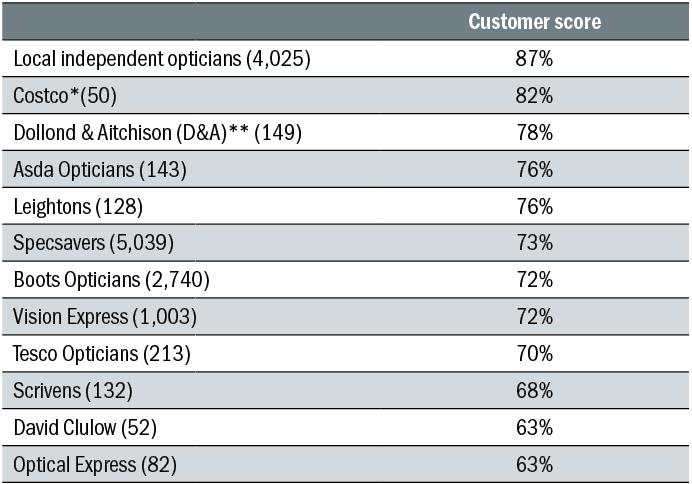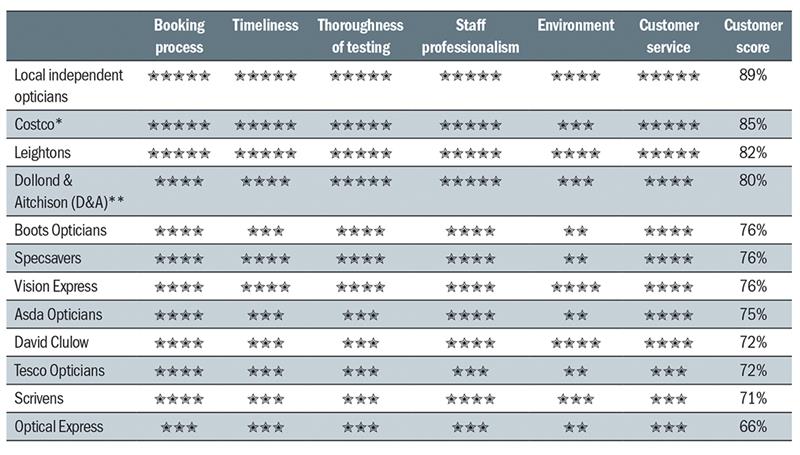Which? magazine reports into the performance of opticians have a tendency to make companies rifle through contacts books to find the details of their PR firms. Some will want press releases, while others will be looking for crisis management.
The group’s investigations are a good barometer of patient attitudes towards eye health participation and purchasing habits, and the results of the Best and Worst Optician Shops 2016 make for interesting reading.
Independents once again topped the tables, with 89% of nearly 8,300 Which? members saying they were satisfied and would recommend them for eye testing. More than eight in 10 would recommend them for buying glasses. Independents also out-scored multiples and chains in the last Which? report of this type in 2014.
In eye testing, independents finished top in every category surveyed. Only in categories relating to cost when buying glasses did others come ahead. They were also the only cohort to score five stars for customer service.
‘It comes as no surprise to AIO that independents once again come out on top in a Which? survey of its members,’ said a confident Association of Independent Optometrists and Dispensing Opticians (AIO) chairman Peter Warren.
‘The results are unequivocal and with 4,029 responses out of the 8,265 provided by Which? members the findings are particularly robust. Our members routinely offer the highest quality patient care, allowing enough consulting time for each patient’s needs and not trying to sell them eye wear that they do not need.
‘Getting this message across to the great British public is the challenge for the independent sector and the AIO is doing its utmost to make this happen.’
The not so good
Optical Express, Scrivens, Tesco Opticians and David Clulow made up the bottom four in the eye testing and overall scores. For the former three, it was the second report in a row in which they were in the bottom three.
Optical Express refuted the findings of the report, which it says was based on a very small sample size. ‘Only 82 respondents in a survey of over 8,200 Which? members actually rated Optical Express – that’s fewer than 1% of all those who took part.
‘The analysis also misrepresents the views of the hundreds of thousands of highly delighted patients we see every year. In a survey of 252,179 Optical Express patients, over 99% told us they would recommend us to their family and friends. We are also rated as “excellent” on independent customer review platform, TrustPilot. The website’s rating is based on over 4,000 patient reviews.’
The multiple scored three stars in: booking process; timeliness; thoroughness of testing; staff professionalism and customer service. Its practice environment scored two stars.

Table 1: Opticians - overall rating
Scrivens was equally surprised by the results: ‘The results do not tally with the results of customer surveys we continuously carry out on our business using much greater numbers than the very small sample (132) in the Which? survey. Nevertheless, we never stop working on improving the delivery of the outstanding clinical care and customer service which has long been the foundation of Scrivens’ success,’ said a company spokesperson.
Tesco Opticians and David Clulow declined to comment on the findings, but it is worth noting the latter had the second smallest sample size, 52.
The report’s authors also identified varied rankings for buying glasses and eye testing. For example, Asda was ranked second out of nine for buying glasses and achieved five star ratings for offers, price and value for money. However, it was eighth for eye testing. For Boots Opticians, the results showed its eye testing was ranked higher than for glasses purchasing. Specsavers was ranked in the middle for both.
Shopping around
Participant feedback on internet purchasing was also covered in the report. Despite a minority of the people surveyed having purchased glasses online, nearly half had done so from Glasses Direct. The online purchasing experience was rated better than the high street by the survey’s respondents, even taking into account the possibility for inaccuracies with high index lenses and varifocals.
‘It’s more common than ever to have your eye test in one store, and to buy glasses in another, or even online,’ said the report’s authors.
This caught the attention of the Optical Confederation (OC), which said the advice given in the article could be unhelpful when buying prescription eyewear.

Table 2: Eye testing
‘Getting the right pair of glasses, with a prescription that suits the user, and a fit that is right as well as comfortable, is more complicated than it seems. Problems with eyewear can be more common when patients exercise their right to take their prescription and shop around,’ said the OC.
Speaking on the OC’s behalf, professional adviser at the Association of Optometrists Geoff Roberson said: ‘Many patients understandably view their prescription as being either “right” or “wrong” but there are many factors involved in the prescribing and dispensing of tailored visual correction wear. The lenses and the fit of the glasses work together towards a good or bad result.
‘Glasses are bespoke items, tailored to individuals’ needs, and not all frames or lens types are suitable for all people so it’s important that a patient gets a professional service which optimises their vision and lifestyle. When buying glasses the things to consider are – purpose, vision correction, quality, fit, comfort and eye health. It is very often better, as well as easier, to have glasses dispensed where the sight test is conducted.’
Optician offered Which? author Joanna Pearl the opportunity to respond. She said the report did include caveats on the subject: ‘The Optical Confederation rightly raised the issue of splitting the patient journey, ie getting their prescription in one place and glasses dispensed in another.
‘We did address the pitfalls of this both in the article and online, while recognising that consumer behaviour and the optical market are changing, saying: “We know that consumers increasingly have their eyes tested in one place, but then buy their glasses elsewhere. The College of Optometrists – the professional body for optometrists – urges caution when splitting prescribing and dispensing glasses, as it is often more difficult and time consuming to resolve any problems.’

Table 3: Buying glasses
Professionalism
Which? also said it agreed with the OC that patients needed and valued a professional service, with staff professionalism being one of the key ratings in its survey. ‘To this end, we have an online guide for consumers including free advice on eye testing, reading prescriptions, including explanations on why some variation is normal, and five steps to the right prescription glasses,’ said a spokesperson for the organisation.
OC chair Chris Hunt took a positive outlook on the findings on the report, saying the result painted a good picture of UK retail optics: ‘As Which? shows, the UK eye health sector is second to none and brings high quality care and choice to over 21 million people a year, protecting the nation’s sight and playing an important public health role in early identification of eye disease. People access optical services for a variety of reasons – to check the health of their eyes, to find affordable vision correction for their lifestyle, including high fashion styles, and to protect their vision, eg from the sun or industrial situations. This is reflected in the wide range of different provider models and approaches patients can choose from while showing universally high scores for satisfaction wherever people decide to go.’
Using the tables
Ratings by 8,265 Which? members make up the customer scores. Some get their eyes tested in one place, but buy glasses elsewhere. Customer scores are based on how members rated separately a) the place where they had their eye test and b) the place where they bought glasses, for likelihood to recommend and satisfaction over the past two years. Sample size is in brackets, and n/a means the number of respondents was too small.
*Costco is a membership warehouse for trade and invidual members (£20 and £25+VAT per year respectively). The sample size for buying glasses at Costco was too small to include.
**Boots and Dollond & Aitchison merged in 2009. Since 2015, all stores are now rebranded as Boots Opticians.
